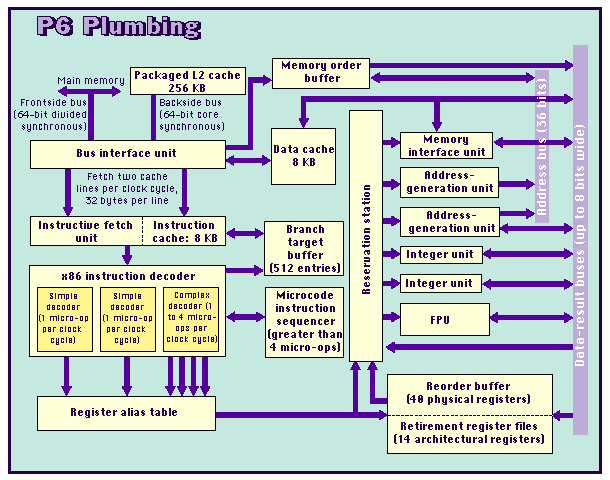| DOSSIER: The first PCs containing Intel's
sixth-generation P6 processor should appear late this
year. Intel originally planned to introduce the P6 at 133
MHz, but thanks to better-than-expected performance from
the initial silicon, Intel now hopes to debut the chip at
150 MHz. Some speed-sorted parts may reach 166 MHz. Even faster clock speeds are coming soon, and Intel designed the superpipelined P6 to handle them. In 1996, the P6 will begin migrating from Intel's 0.6-micron BiCMOS process to a smaller, faster, 0.35-micron BiCMOS process technology. (High-end Pentiums are already fabricated on this process.) The optical shrink could allow Intel's flagship processor to hit 231 MHz by the end of next year. The P6 has a dark side, however. It runs 16-bit software slower than a Pentium does. Intel optimized the P6 for 32-bit code, making compromises that severely impair its performance with older, 16-bit code. As a result, even a Pentium that runs at a slower clock speed than a P6 will do a better job with most of today's mainstream software. (See News & Views, September and October BYTE.) Competitors are ecstatic about this, but Intel is keeping a stiff upper lip. By around 1997, the P6's price should drop low enough to make it a mainstream processor, and 32-bit OSes and applications should be commonplace. Meanwhile, the Pentium will continue to dominate the market for x86 CPUs. Late this year, Intel will introduce a 150-MHz Pentium, to be followed by faster versions in 1996. The 0.35-micron process technology should allow future Pentiums to run at 167 to 180 MHz, and perhaps 200 MHz. These advances at the high end will pull the entire market forward. Today, standard Pentiums run at 75 to 100 MHz; by this time next year, the midpoint will probably be 120 MHz. OFFICIAL INTRODUCTION DATE: Fourth Quarter of 1995 CURRENT STATUS: Entering production LIKELIHOOD INTRODUCTION DATE WILL BE MET: Good TARGET CLOCK SPEED: 150 MHz ESTIMATED PERFORMANCE: 220 SPECint92; 215 SPECfp92 FABRICATION PROCESS/FEATURE SIZE: BiCMOS/0.6-micron TECHNOLOGICAL ADVANTAGES: A multichip package with a 256-KB secondary cache coupled to the CPU at full core speed; out-of-order superscalar microarchitecture; chip is superpipelined for high clock speeds. TECHNOLOGICAL DISADVANTAGES: The multichip package is costly to manufacture; the microarchitecture is tuned for 32-bit software, yielding poor performance with 16-bit code; power consumption and heat dissipation are currently unsuitable for notebook computers. PRIMARY MARKET: Servers and high-end PCs. Where to Find:
Intel
P6 Plumbing The P6 is superpipelined for fast clock
speeds, starting at 150 MHz.
Copyright 1994-1998 BYTE |